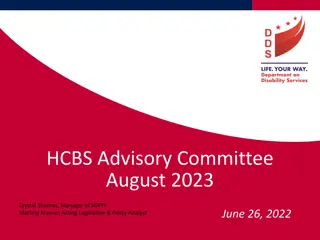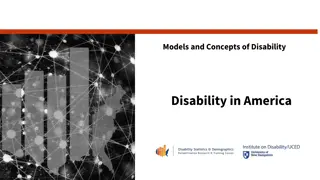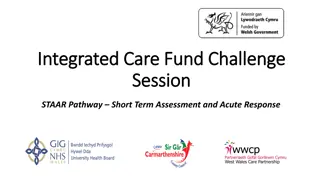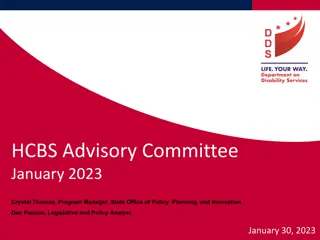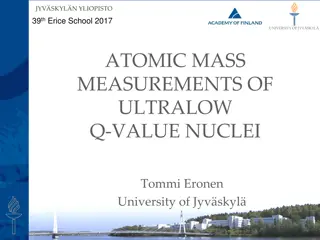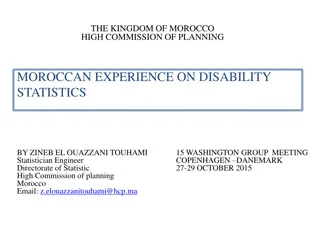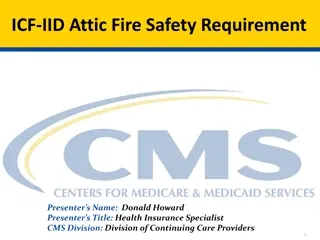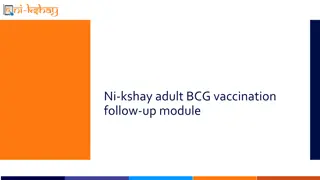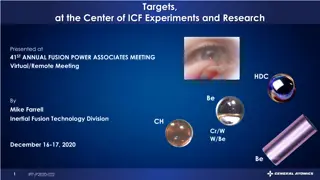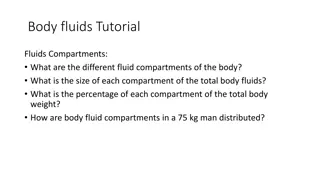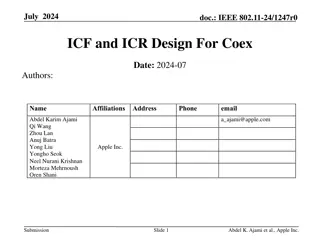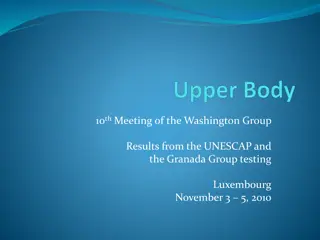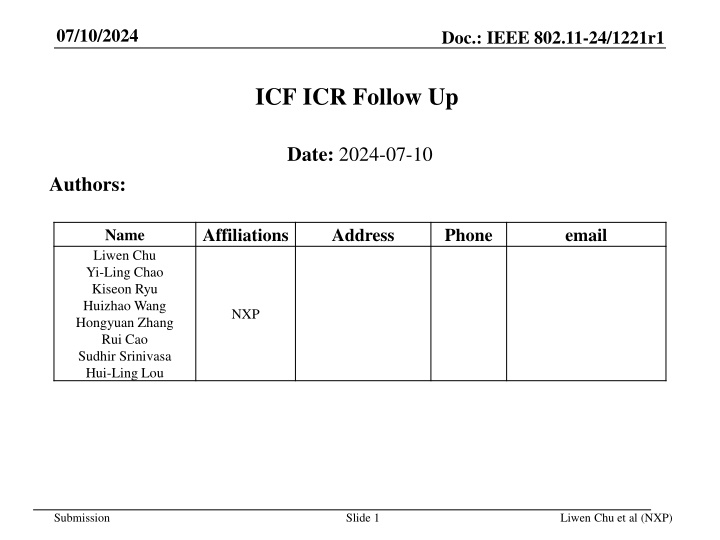
IEEE 802.11-24/1221r1 Initial Control Information Considerations
Explore the considerations related to initial control information in IEEE 802.11-24/1221r1, such as the transmission by APs and non-AP STAs, dynamic control information requests, and frame protection mechanisms. Discover how MU-RTS and BSRP Trigger are utilized for efficient data transmission in various modes.
Download Presentation

Please find below an Image/Link to download the presentation.
The content on the website is provided AS IS for your information and personal use only. It may not be sold, licensed, or shared on other websites without obtaining consent from the author. If you encounter any issues during the download, it is possible that the publisher has removed the file from their server.
You are allowed to download the files provided on this website for personal or commercial use, subject to the condition that they are used lawfully. All files are the property of their respective owners.
The content on the website is provided AS IS for your information and personal use only. It may not be sold, licensed, or shared on other websites without obtaining consent from the author.
E N D
Presentation Transcript
07/10/2024 Doc.: IEEE 802.11-24/1221r1 ICF ICR Follow Up Date: 2024-07-10 Authors: Affiliations Address Phone email Name Liwen Chu Yi-Ling Chao Kiseon Ryu Huizhao Wang Hongyuan Zhang Rui Cao Sudhir Srinivasa Hui-Ling Lou NXP Submission Slide 1 Liwen Chu et al (NXP)
07/10/2024 Doc.: IEEE 802.11-24/1221r1 ICF Consideration ICF can be transmitted by an AP for the following dynamic initial control information: Soliciting non-AP STA s available time and future unavailable time for in-device co- existence. Soliciting non-AP STA s low capability sate to high capability state switch. Reporting AP s future unavailable time for in-device co-existence. ICF can be transmitted by a non-AP STA for the following dynamic initial control information: Soliciting AP s available time and future unavailable time for in-device co-existence. Soliciting AP STA s low capability sate to high capability state switch. Reporting AP s future unavailable time for in-device co-existence. MU-RTS is proposed to replace RTS for non-AP STA s transmission for control frame protection. MU-RTS, BSRP Trigger can be used in EMLSR, low-capability mode to high-capability mode witch where no initial control information is carried in responding frame. Submission Slide 2 Liwen Chu et al (NXP)
07/10/2024 Doc.: IEEE 802.11-24/1221r1 Open Questions of Trigger ICF and ICR The ICF/ICR frame format to carry initial control information needs to be further clarified. In 11-24/494, special User Info field (s) of ICF before Padding field is proposed to carry the initial control information. In 11-24/494, Per AID TID Info field (s) of ICR with special AID value is proposed to carry the initial control information. In 11-24/857, Multi-STA BA as ISR is proposed. When a Trigger is protected, how does a transmitter arrange the PN, MIC and intermediate FCS? Can both the non-AP STA s responding with resource request and the non-AP STA s responding with ICR be solicited in one Trigger frame? If the answer is yes, can an AP explicitly or implicitly indicate whether a BSRP Trigger solicit both resource request and dynamic initial control information? Submission Slide 3 Liwen Chu et al (NXP)
07/10/2024 Doc.: IEEE 802.11-24/1221r1 Common Initial Control Info in ICF Trigger The Common Initial Control Info field with 0 (when no common initial control info exists), one or multiple Type + Length + Content tuples are carried after 16-bit all 1s in the Padding field of the Trigger frame. The Common Initial Control Info Length field indicate the length of the Common Initial Control Info field, e.g. in octets. Another variant is that the Special User Info field indicates whether the Common Initial Control Info exists, and if the Common Initial Control Info exists, the Common Initial Control Info Length is not needed. An addressed STA that needs to check pre-FCS does the following: An addressed STA that doesn t support initial control information but supports control frame protection figures out PN + MIC by decoding the length of each Type + Length + Content. An addressed STA that doesn t support initial control information and control frame protection figures out pre-padding FCS by decoding the length of each Type + Length + Content and then skipping 14-octet PN + MIC. Common Initial Control Info Length Common Initial Control Info MIC Pre-Padding FCS Additional Padding 1111111111111111 PN Variable: Sixteen 1s 8 Octets or 0: variable 4 octets or 0 6 Octets or 0 2 Octets or 0 Protected ICF Trigger Submission Slide 4 Liwen Chu et al (NXP)
07/10/2024 Doc.: IEEE 802.11-24/1221r1 Common Initial Control Info in ICF Trigger The intermediate FCS is after PN and MIC for control frame protection. Common Initial Control Info Length Common Initial Control Info MIC Pre-Padding FCS Additional Padding 1111111111111111 PN Variable: Sixteen 1s 8 Octets or 0: variable 4 octets or 0 6 Octets or 0 2 Octets or 0 Protected ICF Trigger Submission Slide 5 Liwen Chu et al (NXP)
07/10/2024 Doc.: IEEE 802.11-24/1221r1 Mixing Resource Request and ICR or Not Option 1: A BSRP Trigger frame can be used to solicit the responding frames from the following non-AP STAs: Non-AP STA supporting low capability listening and in-device coexistence, Non-AP STA supporting low capability listening, Non-AP STA supporting in-device coexistence, and Non-AP STA not supporting any of the following low capability listening, in-device coexistence. Option 2: A BSRP Trigger frame can be used to solicit the responding frames from the following Non-AP STAs: Either Non-AP STAs supporting low capability listening, Non-AP STAs supporting in-device coexistence, and Or Non-AP STAs not supporting any of the following low capability listening, in-device coexistence. Option 1 is preferable Submission Slide 6 Liwen Chu et al (NXP)
07/10/2024 Doc.: IEEE 802.11-24/1221r1 Mixed ICR Information and Resource Request or Not Option 1: A non-AP STA that supports ICR and is solicited by the first ICF frame will respond with all the following information if supported by the non-AP STA: Available time, and unavailable time (start time and duration) if known, Resource request information. A non-AP STA that supports ICR and is solicited by a Trigger other than the first ICF frame will respond with resource request information. The AP needs to allocate enough resource in the solicited TB PPDU for each addressed STA to transmit all the responding information supported by the AP Available time, and unavailable time (start time and duration) if known, Resource request information. Option 2: In BSRP Trigger frame, the solicited information is explicitly indicated. Option 2 is preferable. Otherwise, a non-AP STA needs to provide the different feedback based on whether it is first polled by the AP. Additionally, the AP and non-AP STA may have the different view about whether AP already correctly receive the ICR feedback. Submission Slide 7 Liwen Chu et al (NXP)
07/10/2024 Doc.: IEEE 802.11-24/1221r1 SP 1 Do you support that if the intermediate FCS and the PN/MIC fields are both present in a Trigger frame then the intermediate FCS shall appear immediately after the PN/MIC field? Submission Slide 8 Liwen Chu et al (NXP)

